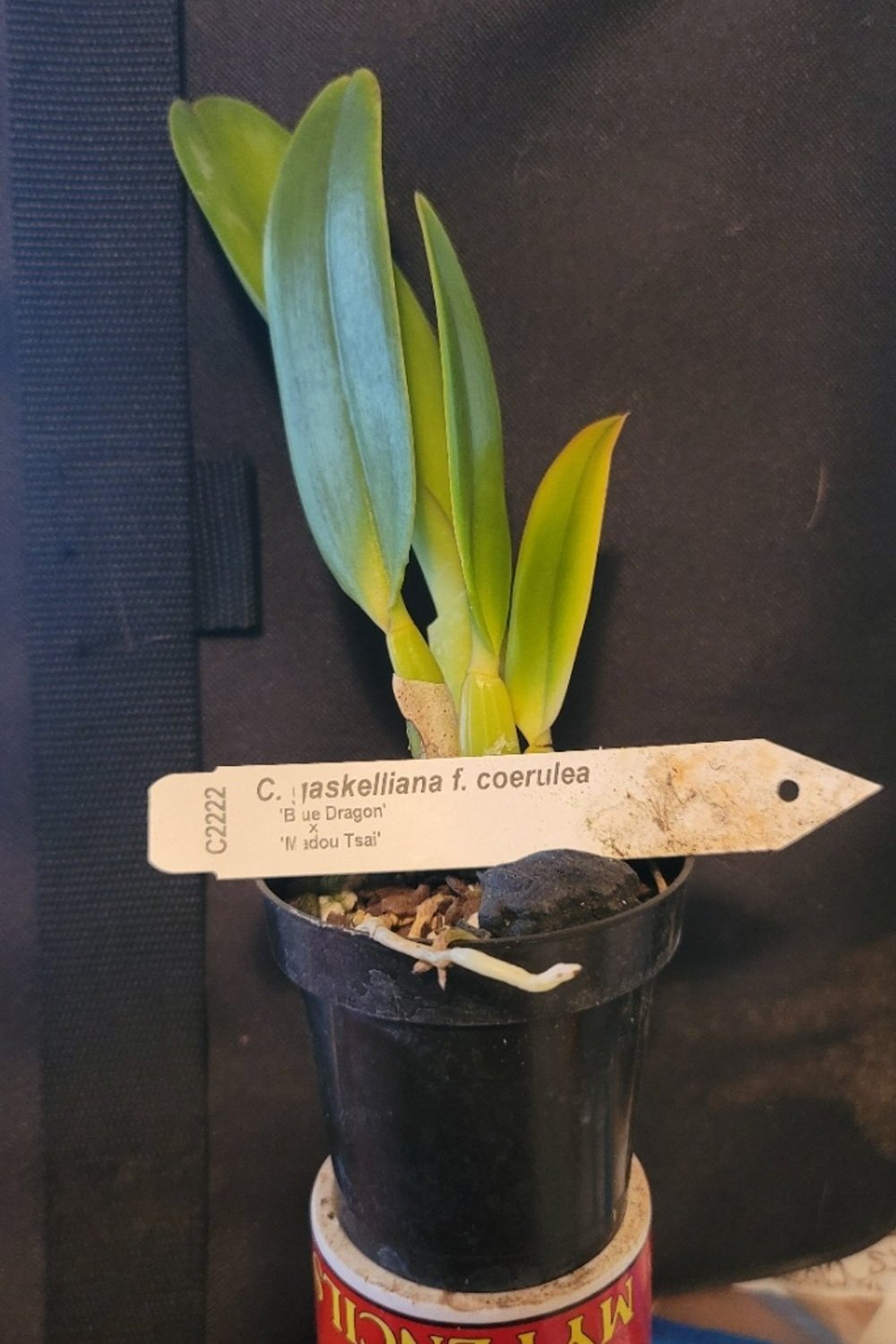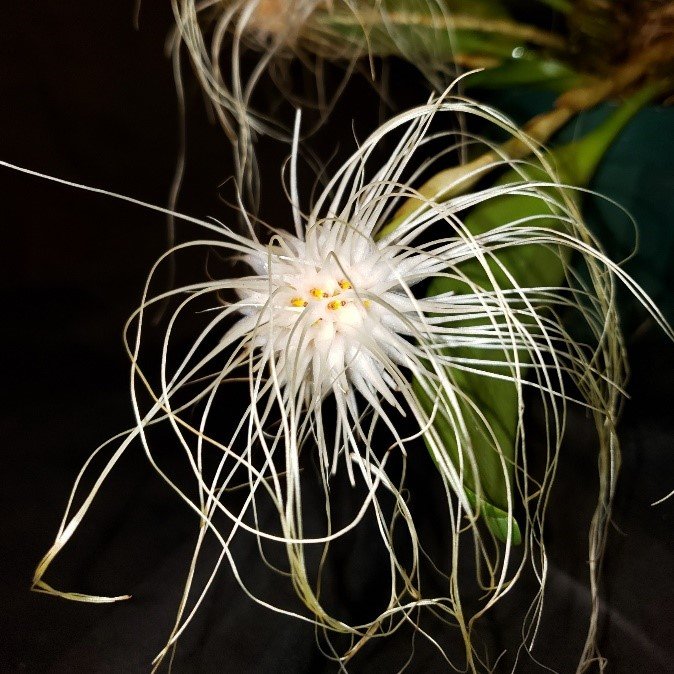 Image 1 of 2
Image 1 of 2

 Image 2 of 2
Image 2 of 2



Cattleya gaskelliana f. coerulea
Cattleya gaskelliana f. coerulea (‘Blue Dragon’ x ‘Madou Tsai’)
Cattleya gaskelliana was first described by Heinrich Gustav Reichenbach in 1883. The f. coerulea designation (from Latin "caeruleus," meaning blue) refers to a naturally occurring variant with blue-toned flowers, distinct from the species’ typical lavender-pink hues. It’s endemic to northern Venezuela and found growing at elevations of 600-1,200 meters epiphytically on trees or as a lithophyte on rocky outcrops in humid montane forests with distinct wet summers and drier winters. The species is prized for its large, fragrant blooms, and the coerulea form adds an uncommon blue twist to its appeal. Our plants are well established, Near Blooming Size (3-in pots) and fully acclimated to outdoor growing in South Florida.Cattleya gaskelliana f. coerulea combines the species’ elegance with a rare blue beauty, offering fragrance and showiness for growers who value uniqueness.
Appearance
Plant Structure:
A bifoliate epiphyte with elongated, cylindrical pseudobulbs (15-30 cm tall), each bearing two leathery leaves (15-25 cm long, oblong, and dark green).
Growth habit is upright and sturdy, typical of large-flowered Cattleya species.
Flowers:
Size: Large, 12-15 cm (5-6 inches) across, slightly smaller than some Cattleya giants like C. mossiae but still impressive.
Color: In the f. coerulea form, petals and sepals are pale bluish-lavender to soft lilac, often with a subtle grayish or silvery cast. The lip is a deeper blue-violet, sometimes with faint yellow or greenish-yellow veining in the throat—a remnant of the species’ typical coloration. This contrasts with standard C. gaskelliana, which features lavender to pink petals and a darker magenta-purple lip with a yellow center.
Shape: Broad, rounded petals and sepals with a prominent, ruffled lip that’s tubular at the base and flares out widely—a classic Cattleya profile.
Count: 2-5 flowers per inflorescence, emerging from a terminal sheath on new growths.
Fragrance: Strongly fragrant, with a sweet, floral scent often compared to roses or citrus, retained in the coerulea form.
Cattleya gaskelliana f. coerulea (‘Blue Dragon’ x ‘Madou Tsai’)
Cattleya gaskelliana was first described by Heinrich Gustav Reichenbach in 1883. The f. coerulea designation (from Latin "caeruleus," meaning blue) refers to a naturally occurring variant with blue-toned flowers, distinct from the species’ typical lavender-pink hues. It’s endemic to northern Venezuela and found growing at elevations of 600-1,200 meters epiphytically on trees or as a lithophyte on rocky outcrops in humid montane forests with distinct wet summers and drier winters. The species is prized for its large, fragrant blooms, and the coerulea form adds an uncommon blue twist to its appeal. Our plants are well established, Near Blooming Size (3-in pots) and fully acclimated to outdoor growing in South Florida.Cattleya gaskelliana f. coerulea combines the species’ elegance with a rare blue beauty, offering fragrance and showiness for growers who value uniqueness.
Appearance
Plant Structure:
A bifoliate epiphyte with elongated, cylindrical pseudobulbs (15-30 cm tall), each bearing two leathery leaves (15-25 cm long, oblong, and dark green).
Growth habit is upright and sturdy, typical of large-flowered Cattleya species.
Flowers:
Size: Large, 12-15 cm (5-6 inches) across, slightly smaller than some Cattleya giants like C. mossiae but still impressive.
Color: In the f. coerulea form, petals and sepals are pale bluish-lavender to soft lilac, often with a subtle grayish or silvery cast. The lip is a deeper blue-violet, sometimes with faint yellow or greenish-yellow veining in the throat—a remnant of the species’ typical coloration. This contrasts with standard C. gaskelliana, which features lavender to pink petals and a darker magenta-purple lip with a yellow center.
Shape: Broad, rounded petals and sepals with a prominent, ruffled lip that’s tubular at the base and flares out widely—a classic Cattleya profile.
Count: 2-5 flowers per inflorescence, emerging from a terminal sheath on new growths.
Fragrance: Strongly fragrant, with a sweet, floral scent often compared to roses or citrus, retained in the coerulea form.
Cattleya gaskelliana f. coerulea (‘Blue Dragon’ x ‘Madou Tsai’)
Cattleya gaskelliana was first described by Heinrich Gustav Reichenbach in 1883. The f. coerulea designation (from Latin "caeruleus," meaning blue) refers to a naturally occurring variant with blue-toned flowers, distinct from the species’ typical lavender-pink hues. It’s endemic to northern Venezuela and found growing at elevations of 600-1,200 meters epiphytically on trees or as a lithophyte on rocky outcrops in humid montane forests with distinct wet summers and drier winters. The species is prized for its large, fragrant blooms, and the coerulea form adds an uncommon blue twist to its appeal. Our plants are well established, Near Blooming Size (3-in pots) and fully acclimated to outdoor growing in South Florida.Cattleya gaskelliana f. coerulea combines the species’ elegance with a rare blue beauty, offering fragrance and showiness for growers who value uniqueness.
Appearance
Plant Structure:
A bifoliate epiphyte with elongated, cylindrical pseudobulbs (15-30 cm tall), each bearing two leathery leaves (15-25 cm long, oblong, and dark green).
Growth habit is upright and sturdy, typical of large-flowered Cattleya species.
Flowers:
Size: Large, 12-15 cm (5-6 inches) across, slightly smaller than some Cattleya giants like C. mossiae but still impressive.
Color: In the f. coerulea form, petals and sepals are pale bluish-lavender to soft lilac, often with a subtle grayish or silvery cast. The lip is a deeper blue-violet, sometimes with faint yellow or greenish-yellow veining in the throat—a remnant of the species’ typical coloration. This contrasts with standard C. gaskelliana, which features lavender to pink petals and a darker magenta-purple lip with a yellow center.
Shape: Broad, rounded petals and sepals with a prominent, ruffled lip that’s tubular at the base and flares out widely—a classic Cattleya profile.
Count: 2-5 flowers per inflorescence, emerging from a terminal sheath on new growths.
Fragrance: Strongly fragrant, with a sweet, floral scent often compared to roses or citrus, retained in the coerulea form.
Growing Conditions
Light: Bright, indirect light (2,500-3,500 foot-candles). Morning sun or filtered light is ideal; insufficient light delays blooming.
Temperature: Intermediate to warm, 60°F-85°F (15.5°C-29°C). Tolerates cooler nights (50°F/10°C) during winter rest.
Humidity: 50%-70%. Higher humidity supports growth, especially in summer.
Watering: Water when the medium (coarse bark or mounted) dries—weekly in summer, less in winter during dormancy. Avoid water in sheaths to prevent rot.
Fertilizer: Weekly 1/2 strength orchid fertilizer (e.g., 20-20-20) during growth (spring-summer), reduced in fall-winter.
Blooming
Season: Summer (June-August in the Northern Hemisphere), slightly later than spring-blooming relatives like C. mossiae.
Trigger: A dry rest in late winter/early spring (reduced watering after pseudobulbs mature) followed by increased light and water as new growths emerge.
Duration: Flowers last 2-4 weeks, longer in cooler, humid conditions.
Unique Traits
Blue Rarity: The coerulea form is exceptionally rare, offering a cool-toned contrast to the warm hues typical of Cattleya species. True blue is scarce in orchids, making this a collector’s treasure.
Fragrance: Retains the strong, pleasant scent of C. gaskelliana, a trait not always preserved in coerulea variants of other species.
Historical Value: C. gaskelliana contributed to early Cattleya breeding (e.g., C. Suzanne Hye), and f. coerulea adds a unique chapter to its legacy.
Care Tips
Potting: Use medium to coarse bark or mount on cork/wood for drainage and air exposure. Repot post-blooming when new roots appear.
Rest Period: Essential for flowering—reduce water in winter, resuming with spring growth.
Pests: Monitor for scale or spider mites, common Cattleya pests, though not unusually prone.








